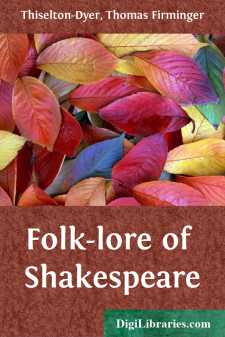Categories
- Antiques & Collectibles 13
- Architecture 36
- Art 48
- Bibles 22
- Biography & Autobiography 813
- Body, Mind & Spirit 142
- Business & Economics 28
- Children's Books 17
- Children's Fiction 14
- Computers 4
- Cooking 94
- Crafts & Hobbies 4
- Drama 346
- Education 46
- Family & Relationships 57
- Fiction 11829
- Games 19
- Gardening 17
- Health & Fitness 34
- History 1377
- House & Home 1
- Humor 147
- Juvenile Fiction 1873
- Juvenile Nonfiction 202
- Language Arts & Disciplines 88
- Law 16
- Literary Collections 686
- Literary Criticism 179
- Mathematics 13
- Medical 41
- Music 40
- Nature 179
- Non-Classifiable 1768
- Performing Arts 7
- Periodicals 1453
- Philosophy 64
- Photography 2
- Poetry 896
- Political Science 203
- Psychology 42
- Reference 154
- Religion 513
- Science 126
- Self-Help 84
- Social Science 81
- Sports & Recreation 34
- Study Aids 3
- Technology & Engineering 59
- Transportation 23
- Travel 463
- True Crime 29
Folk-lore of Shakespeare
Description:
Excerpt
CHAPTER I.
FAIRIES.
The wealth of Shakespeare’s luxuriant imagination and glowing language seems to have been poured forth in the graphic accounts which he has given us of the fairy tribe. Indeed, the profusion of poetic imagery with which he has so richly clad his fairy characters is unrivalled, and the “Midsummer-Night’s Dream” holds a unique position in so far as it contains the finest modern artistic realization of the fairy kingdom. Mr. Dowden, in his “Shakspere Primer” (1877, pp. 71, 72) justly remarks: “As the two extremes of exquisite delicacy, of dainty elegance, and, on the other hand, of thick-witted grossness and clumsiness, stand the fairy tribe and the group of Athenian handicraftsmen. The world of the poet’s dream includes the two—a Titania, and a Bottom the weaver—and can bring them into grotesque conjunction. No such fairy poetry existed anywhere in English literature before Shakspere. The tiny elves, to whom a cowslip is tall, for whom the third part of a minute is an important division of time, have a miniature perfection which is charming. They delight in all beautiful and dainty things, and war with things that creep and things that fly, if they be uncomely; their lives are gay with fine frolic and delicate revelry.” Puck, the jester of fairyland, stands apart from the rest, the recognizable “lob of spirits,” a rough, “fawn-faced, shock-pated little fellow, dainty-limbed shapes around him.” Judging, then, from the elaborate account which the poet has bequeathed us of the fairies, it is evident that the subject was one in which he took a special interest. Indeed, the graphic pictures he has handed down to us of
“Elves of hills, brooks, standing lakes and groves;And ye, that on the sands with printless foot,
Do chase the ebbing Neptune, and do fly him
When he comes back; you demy-puppets that
By moonshine do the green-sour ringlets make
Whereof the ewe not bites,” etc.,
show how intimately he was acquainted with the history of these little people, and what a complete knowledge he possessed of the superstitious fancies which had clustered round them. In Shakespeare’s day, too, it must be remembered, fairies were much in fashion; and, as Johnson remarks, common tradition had made them familiar. It has also been observed that, well acquainted, from the rural habits of his early life, with the notions of the peasantry respecting these beings, he saw that they were capable of being applied to a production of a species of the wonderful. Hence, as Mr. Halliwell-Phillipps has so aptly written, “he founded his elfin world on the prettiest of the people’s traditions, and has clothed it in the ever-living flowers of his own exuberant fancy.” Referring to the fairy mythology in the “Midsummer-Night’s Dream,” it is described by Mr. Keightley as an attempt to blend “the elves of the village with the fays of romance.” His fairies agree with the former in their diminutive stature—diminished, indeed, to dimensions inappreciable by village gossips—in their fondness for dancing, their love of cleanliness, and their child-abstracting propensities....


